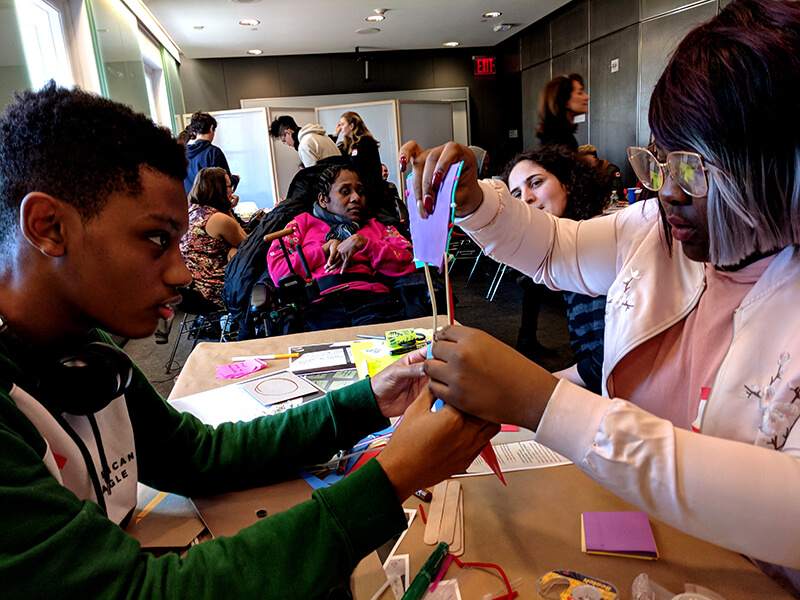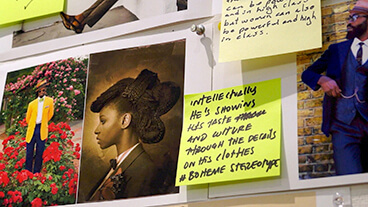Perspective
Linking Social and Emotional Learning to Digital Learning through Collaboration and Empathy
Chelsey Hauge
Rafi Santo - New York University
What does digital learning have to do with social and emotional learning? This resource explores linkages, highlighting ways that digital learning programs can support youth outcomes around collaboration and empathy.

What’s the Issue?
Sometimes, it seems as though we must choose between digital learning and nurturing social and emotional learning (SEL) opportunities with young people. Somewhere, somehow, feelings of empathy, emotion and trust became unmoored from digital engagement, and yet – because our world is increasingly defined by mediated networks and engagement with technology – the need to emphasize social and emotional development in digital learning is increasingly urgent.
Despite the perceived break between SEL and digital learning, both digital media organizational ethos and the everyday practices of organizations doing digital learning work with young people suggest that there is a strong bridge between social and emotional development and digital learning, and that they can reinforce and strengthen each other. In this resource, we explore how organizations with digital learning programs weave SEL into their practices, particularly those related to collaboration; practices involved in working effectively and respectfully with others, and empathy; practices related to perspective taking.

What Does it Look Like?
Here, we explore how social and emotional learning skills of collaboration and empathy are woven through curricular and programmatic practices in digital learning programs.
Exploring Difference through Digital Design and Storytelling
At Dreamyard, in a partnership with Mouse, a technology education organization, students in the Design League program work with an organization focused on serving people with special needs. Hillary Kolos, Director of Digital Learning at DreamYard, describes the process of students working with those with cerebral palsy to identify design opportunities around assistance technologies:
Students learn about human centered design skills. And then, they interview people served by the organization, identifying needs they have that could be addressed through new technologies. They go on to develop tech prototypes with the help of tech mentors.
This partnership allows students to deepen their skills in digital media and experience using their skill set to effectively help another group, developing empathy for those with an experience different from their own. In terms of social and emotional skill development, being able to constructively contribute in a concrete way to a population that is differently disadvantaged is an excellent opportunity.
Another opportunity for empathy development in digital learning comes through practices of storytelling. In an example of this coming from WMCAT, based in Grand Rapids, Michigan, a group of young people were interested in learning about how to use 8mm film in a project that also used digital video. In attempting to identify a story that would ‘work’ with 8mm film, they chose to focus on the story of a youth in the group who was a recent immigrant. They elected to tell a story in which he had a flashback during a therapy session to part of his immigration story, with the driving idea being that memory could be visually captured through the grainy nature of 8mm film.
This is a powerful example of the relationship between technology education and the development of empathy. The 8mm film was what spurred the decision to focus on this young person’s experience, and enabled the group of youth to engage in witnessing their peers’ immigration story. Here, it is both the interest in this media technology (8mm), the collaborative nature of media production (each student in the group had a role to play), and the impetus to tell someone’s story that opens up a space of empathic witnessing, where the student at the center of the story is invited to trust his peers with his story as they explore the aesthetic dimensions of representing memory about immigration and youthfulness. The student at the center of the story was offered an opportunity to magnify his voice, while his peers offered witnessing and production support — woven together with thoughtfulness about the aesthetics associated with particular media technologies — that enabled the story to be told.
Building Empathy and Collaborative Skills through Media Production Teams
Another way to build opportunities for development of empathy, as well as collaboration skills, among young people is in the ‘production team’ approach used by Free Spirit Media, a Chicago-based organization focused on film and journalism. Young people are placed into media production teams with defined roles, and rotate through the roles. The same young person might first serve as a scriptwriter, then a director of photography, then an editor, and so on. What’s important here is that there is an intentional shuffling of roles. More advanced students may focus becoming more proficient at particular roles, but early on, students at Free Spirit Media begin to develop perspective-taking through this programmatic structure. The ability to move between perspectives and understand the process of media production from different lenses is an important part of developing empathy, and helps them become better collaborators. This structural component to Free Spirit Media’s production process allows students to practice moving between and across perspectives, therefore offering a template for them in terms of how to consider issues, and collaborative processes, they may come across in the future.
Guiding Questions
- Can you set up conversations and engagement opportunities
for youth with others that are different from them in your
digital learning programs? - How can different mediums inspire the telling of diverse
stories? - Can you intentionally support youth to movebetween different
roles in your digital learning programs so that they can
practice different perspective-taking? - Do you want young people to tell and/or share their own stories,
or do you want them to tell/share the stories of other
people?
What Does it Lead To?
The practices outlined above offer opportunities for young people to develop both empathy and collaboration skills through digital learning projects. Many of these practices likely require that staff are deeply engaged in relationship building with young people and also, that they work very closely with young people so that they may coach and facilitate in real-time, alongside youth as they move between technological and social and emotional realms. Enacting curricular practices that deepen the relationship between social and emotional learning and media/technology lead to:
- Culturally relevant pedagogy. A commitment to making programming relevant to the lives, communities, and histories of the youth involved
- Opportunities for perspective-taking. Allowing young people to practice viewing issues that are important to them from diverse viewpoints, as well as exploring different roles that others play in teams.
- Understanding relational elements of digital design. Having youth come to an understanding that creation with various forms of digital media isn’t just a technical endeavor, but a human one.
The Role of Media and Technology
The relationship between these particular forms of socio-emotional learning are deeply linked to the processes of digital production and technology development. Let’s return here to the WMCAT example in which the group of youth, curious about how and when to use 8mm film, elected to tell a story of memory and immigration, because they imagined that 8mm would aesthetically represent memory. Here, curiosity about a new medium drove the young people to engage with one of their own stories, and to amplify a voice and story that otherwise might not be heard. In the example of Design League, the entire process of learning about and developing new technologies is rooted in an approach that centers empathy – human centered design around problems experienced by a particular population. Similarly, in the case of Free Spirit Media, the skills of collaboration are developed through the needs for multiple roles involved in a film production process. Through engagement with making, creating, designing and exploring with media and technology, young people are able to move into spaces that challenge them to engage with the development of social and emotional skills.
Tensions and Challenges
Perhaps the most significant tension around social and emotional skills and digital learning remains the challenge we opened with: the very real perception that digital engagement cannot enhance social and emotional awareness or engagement. The first challenge to overcome is the perception that ‘the digital’ and ‘the social’ don’t have a relationship.
Related Resources
- Preparing Youth to Thrive: Promising Practices for Social
and Emotional Learning, report and website from The
Weikart Center for Youth Program Quality. - Zine about Design League, from Mouse.
In thinking particularly about the examples we shared on empathy development, it’s important to avoid situations where youth involved in design or storytelling around marginalized populations develop a ‘savior’ dynamic, one where they come to see themselves are solving the problems of a community unable to do, or tell the story because someone else can’t. Instead, position youth involved in these empathy-rooted projects as working in solidarity with individuals, actively listening to what they’re saying, and avoiding tokenizing their experience.
Finally, with regards to collaborative practices, it’s important to acknowledge that focusing on developing true group work might come somewhat at the expense of an ‘efficient’ process of media production. Some youth might be more skilled across a range of roles, which could easily lead to having them take an outsized role in contributing to different roles. But, in order to equitably give all youth an opportunity to learn both technical and social skills, it’s important to keep an eye on how the collaborative process plays out.